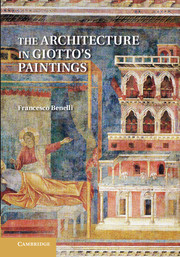Description
The Architecture in Giotto's Paintings
Author: Benelli Francesco
Benelli shows how Giotto's images of buildings and well-known monuments play an important role in the meaning of his works.
Language: EnglishApproximative price 50.94 €
In Print (Delivery period: 14 days).
Add to cart
The Architecture in Giotto's Paintings
Publication date: 07-2014
296 p. · 17.7x25.4 cm · Paperback
Publication date: 07-2014
296 p. · 17.7x25.4 cm · Paperback
Approximative price 110.37 €
In Print (Delivery period: 14 days).
Add to cart
The architecture in giotto's paintings
Publication date: 12-2011
300 p. · 18.5x26 cm · Hardback
Publication date: 12-2011
300 p. · 18.5x26 cm · Hardback
Description
/li>Contents
/li>Biography
/li>
This book offers an analysis of Giotto's painted architecture, focusing on issues of structural logic, clarity of composition, and its role within the narrative of the painting. Giotto was the first artist since antiquity to feature highly-detailed architecture in a primary role in his paintings. Francesco Benelli demonstrates how architecture was used to create pictorial space, one of Giotto's key inventions. He argues that Giotto's innovation was driven by a new attention to classical sources, including low reliefs, mosaics, mural paintings, coins, and Roman ruins. The book shows how Giotto's images of fictive buildings, as well as portraits of well-known monuments, both ancient and contemporary, play an important role in the overall narrative, iconography, and meaning of his works. The conventions established by Giotto remained at the heart of early modern Italian painting until the sixteenth century.
Introduction; 1. The cycle of the Legend of San Francis in the upper church of Assisi; 2. The Enrico Scrovegni chapel in Padua; 3. The Peruzzi and Bardi chapels in the church of Santa Croce in Florence; 4. The lower church of Assisi; 5. Giotto's influence in the lower church of Assisi and the church of Santa Croce in Florence; 6. Excursus; Conclusion.
Francesco Benelli is Associate Professor of Renaissance Architecture in the Department of Art History and Archaeology at Columbia University. He was the recipient of the Mellon Postdoctoral Fellowship at Columbia University and a Fellow at the Kunsthistorisches Institut in Florence. He has published widely on several aspects of Renaissance architecture, as well as on issues of building material and technique and the history of design and construction.
© 2024 LAVOISIER S.A.S.





